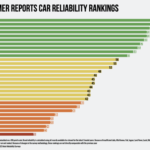Energy News Beat
Key Takeaways
Despite the Biden Administration arguing that electric vehicles are more reliable, Consumer Reports analyzed consumer data showing EVs trail conventional vehicles significantly.
EV owners suffer from 79 percent more reliability issues than gasoline or diesel vehicles.
Plug-in hybrids are even worse, with 146 percent more reliability issues, although straight hybrids are more reliable than conventional vehicles.
Some automakers are losing massive sums on each EV produced despite massive subsidies.
According to Consumer Reports, electric vehicles have 79 percent more reliability problems than a gasoline- or diesel-powered vehicle, on average. Plug-in hybrids fared even worse; they have 146 percent more issues on average than the conventional alternative. Simpler not-plug-in hybrids, on the other hand, have 26 percent fewer reliability problems than conventionally powered vehicles. Electric vehicles should be easier to maintain according to the Department of Energy, since they have many fewer moving parts than their petroleum-based counterparts. According to data collected by Consumer Reports, however, electric vehicles are significantly less reliable than conventionally powered cars. Consumer Reports based this decision on data from 330,000 owners of vehicles from the last three model years. The survey covers 20 potential problem areas, including engine, transmission, electric motors, leaks, and infotainment systems. It uses the survey data to generate reliability scores for each vehicle and model year.
Source: Consumer Reports
Most electric cars today are being manufactured by either legacy automakers that are new to EV technology, or new companies like Rivian that have not manufactured cars before. These companies are having growing pains and need time to work out bugs. Some of the most common problems EV owners report are issues with electric drive motors, charging components on the vehicle, and EV batteries.
Tesla, which has been building electric vehicles for more than a decade, falls near the middle of the pack in terms of vehicle reliability. Its Model Y, first introduced for model year 2020, is recommended by Consumer Reports for the first time this year, with owners reporting fewer issues with its suspension, in-car electronics and general build quality than in previous years. The Model Y joins the Model 3 in earning Consumer Report Recommended status. Tesla has more experience producing electric vehicles than any other automaker.
While Tesla powertrains are now pretty solid, Tesla owners report build quality issues including irregular paint, broken trim, door handles that do not work, and trunks that do not close, which pull down the reliability score. Consumer Reports factors build quality issues that require repair into its reliability calculations, but they are not weighted as heavily as more serious problems, such as those that affect the engine, transmission, or drivetrain.
As mentioned above, this year’s survey show that hybrids continue to be among the most reliable vehicle type, having 26 percent fewer problems than conventional models, even though they have both a conventional powertrain and an electric motor and therefore have more potential problem areas than conventional cars. Toyota launched the Prius hybrid about 25 years ago, which is long enough to get good at its manufacture. Plus, many hybrids are also made by manufacturers that tend to produce reliable vehicles overall, such as Toyota, Hyundai, and Kia. Hybrids also are not typically loaded with high-tech features like multiple customizable displays that can be problem-prone, so less can go wrong with them. Some have suggested electric vehicles are actually “computers on wheels” because of their reliance upon them for most functions.
As mentioned above plug-in hybrid electric vehicles, which have both a battery for short-range electric driving and an internal combustion engine for long-range driving, are the least reliable vehicle category with 146 percent more problems than conventional cars. They are essentially a combined electric vehicle and conventional car, so they have more things that can go wrong.
A conventionally powered car, truck, or SUV has 17 main problem areas, including build quality issues and engine and transmission issues. Plug-in hybrid electric vehicles have all these plus electric motors, a high-voltage traction battery, and charging components. Not-plugged-in hybrids have 19 potential problem areas—all the above minus the charging problem—and electric vehicles have 12, since they do not have internal combustion engines, fueling systems, or transmissions.
For comparison, consider the conventional version of the Chrysler Pacifica minivan, which has a reliability score high enough to be recommended this year. But the reliability score of the plugged in hybrid EV version of the Pacifica is well below average and is not recommended due to issues with the hybrid drivetrain and charging system. Charging systems are highly complex because they monitor the charging to the EVs’ batteries to ensure safe charging of the very expensive components which make up the battery packs.
Reliability Rankings
In general, Asian auto makers dominate the upper end of the reliability chart, although Mini, Porsche, and BMW also made the top 10 shown below. Tesla placed in the middle of the group, along with other domestic brands like Buick, Ram, Cadillac, Chevrolet, and Dodge. Ford is in 22nd place overall, and many of its best-sellers like the F-150 and Bronco suffer from below-average reliability, as does the F-150 Lightning and the F-150 hybrid, though the Ford Maverick and Edge have above-average reliability ratings. Chrysler is at the bottom with the least reliable vehicle overall, the Pacifica Hybrid.
Source: ars Technica
Reliability Problems Could Get Worse As Auto Makers Rush to Make Cheaper EVs
Legacy auto makers are rushing to produce lower-priced electric vehicles more quickly due to pending competition from Chinese auto makers, who are making electric vehicles cheaply as they dominate the EV battery supply chain and the critical mineral processing needed for electric vehicles, and also have cheap electricity from the country’s many coal plants. Renault plans a 40 percent cost reduction for its electric vehicles to reach price parity with fossil-fuel models. Stellantis is building a European plant with China’s battery maker CATL to make cheaper batteries and has recently unveiled the Citroen electric e-C3 SUV, which starts at 23,300 euros ($24,540). Volkswagen and Tesla are developing 25,000-euro electric vehicles.
U.S. auto makers, who are somewhat protected from Chinese EV imports by subsidies in the Inflation Reduction Act, also are planning to manufacture more affordable electric vehicles. GM has saved billions partly by developing a more inexpensive battery pack for its revamped Bolt EV, which will launch in 2025, two years earlier than planned. Ford is cutting costs partly through a 50 percent increase in “in-sourcing” of parts like batteries and inverters. The feasibility of lowering costs, however, is yet to be seen as Ford has indicated that it is losing over $60,000 per electric vehicle, despite the massive subsidies from the Inflation Reduction Act. The average new EV sold for about $52,000 in October, down from around $65,000 a year ago, according to Cox Automotive.
The Texas Policy Foundation’s research demonstrates that electric vehicles benefit from hidden subsidies that total nearly $50,000 per electric vehicle, paid for by gasoline vehicle owners, taxpayers, and utility ratepayers. Electric vehicles primarily benefit from regulatory credits and generous fuel economy standards, which average $27,881 per vehicle. Electric vehicles have been given a 6.67 multiplier to their rated fuel economy by the Department of Energy, so that an EV with a rated fuel economy of 100 miles per gallon is credited as if it is getting 667 miles per gallon. Furthermore, the EPA’s proposed tail pipe emission rule and the Department of Transportation’s fuel economy standards require that 67 percent of new cars sold be all-electric by 2032, demonstrating a clear Biden administration preference toward electric vehicles.
Electric vehicles require new charging infrastructure, and their large power draw increases the strain on electricity infrastructure. A typical EV charging overnight at home consumes as much power as several homes, and an EV charging at a fast-charging station in 30 minutes consumes as much power as a small to medium-sized grocery store. Widespread EV adoption will require significant and expensive grid upgrades. EV owners are not paying these increased electricity costs, which average $11,833 per vehicle over 10 years, by themselves. Unless and until utilities start charging EV owners for the extra infrastructure costs to serve them, those costs are shared among all the utility’s customers. Residential electricity costs across the United States have risen over 20 percent since Biden has taken office, and a rapid forced adoption of electric vehicles will increase those costs further to pay for the increased demands electric vehicles place upon the system, among other energy transition reasons.
Direct federal and state subsidies provide electric vehicles with another $8,984 per vehicle over 10 years, including the $7,500 federal tax credit in the Inflation Reduction Act and smaller state subsidies for electric vehicles. These subsidies are borne by the American taxpayer.
Conclusion
According to data collected by Consumer Reports, electric vehicles are significantly less reliable than conventionally powered cars. Auto makers globally are trying to improve EV reliability, but they are also trying to reduce costs due to sagging sales and competition from Chinese models. The reality, however, is that auto makers are losing money on every electric vehicle they build, even though EVs are heavily subsidized by gasoline and diesel vehicle owners, taxpayers and utility ratepayers.
The post Electric Vehicles Are Less Reliable than Conventional Cars appeared first on Energy News Beat.








